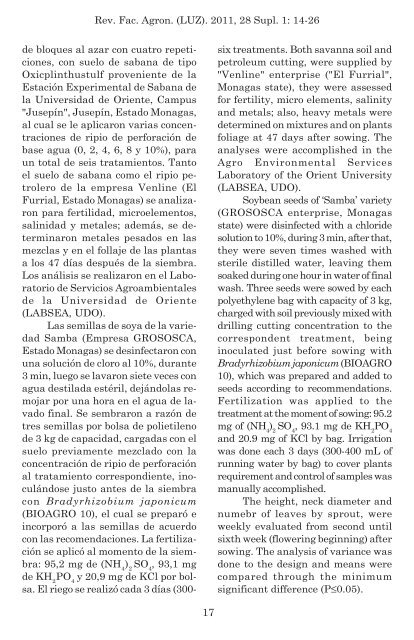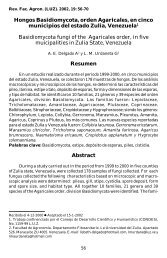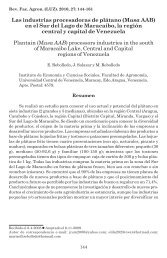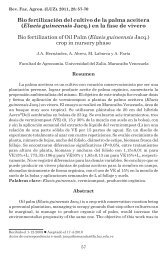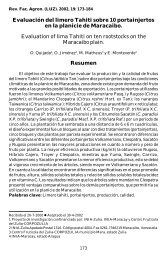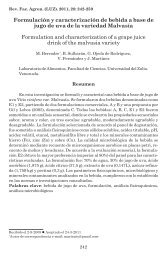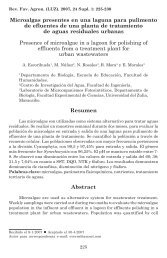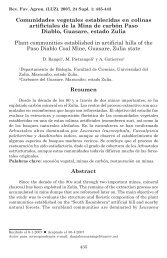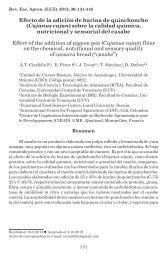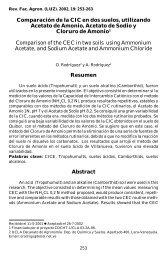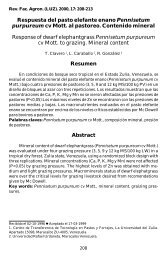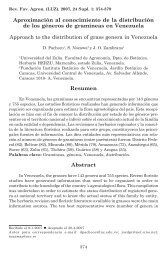Efectos de ripio de perforación petrolera de base agua sobre el ...
Efectos de ripio de perforación petrolera de base agua sobre el ...
Efectos de ripio de perforación petrolera de base agua sobre el ...
Create successful ePaper yourself
Turn your PDF publications into a flip-book with our unique Google optimized e-Paper software.
Rev. Fac. Agron. (LUZ). 2011, 28 Supl. 1: 14-26<br />
<strong>de</strong> bloques al azar con cuatro repeticiones,<br />
con su<strong>el</strong>o <strong>de</strong> sabana <strong>de</strong> tipo<br />
Oxicplinthustulf proveniente <strong>de</strong> la<br />
Estación Experimental <strong>de</strong> Sabana <strong>de</strong><br />
la Universidad <strong>de</strong> Oriente, Campus<br />
"Jusepín", Jusepín, Estado Monagas,<br />
al cual se le aplicaron varias concentraciones<br />
<strong>de</strong> <strong>ripio</strong> <strong>de</strong> perforación <strong>de</strong><br />
<strong>base</strong> <strong>agua</strong> (0, 2, 4, 6, 8 y 10%), para<br />
un total <strong>de</strong> seis tratamientos. Tanto<br />
<strong>el</strong> su<strong>el</strong>o <strong>de</strong> sabana como <strong>el</strong> <strong>ripio</strong> petrolero<br />
<strong>de</strong> la empresa Venline (El<br />
Furrial, Estado Monagas) se analizaron<br />
para fertilidad, micro<strong>el</strong>ementos,<br />
salinidad y metales; a<strong>de</strong>más, se <strong>de</strong>terminaron<br />
metales pesados en las<br />
mezclas y en <strong>el</strong> follaje <strong>de</strong> las plantas<br />
a los 47 días <strong>de</strong>spués <strong>de</strong> la siembra.<br />
Los análisis se realizaron en <strong>el</strong> Laboratorio<br />
<strong>de</strong> Servicios Agroambientales<br />
<strong>de</strong> la Universidad <strong>de</strong> Oriente<br />
(LABSEA, UDO).<br />
Las semillas <strong>de</strong> soya <strong>de</strong> la variedad<br />
Samba (Empresa GROSOSCA,<br />
Estado Monagas) se <strong>de</strong>sinfectaron con<br />
una solución <strong>de</strong> cloro al 10%, durante<br />
3 min, luego se lavaron siete veces con<br />
<strong>agua</strong> <strong>de</strong>stilada estéril, <strong>de</strong>jándolas remojar<br />
por una hora en <strong>el</strong> <strong>agua</strong> <strong>de</strong> lavado<br />
final. Se sembraron a razón <strong>de</strong><br />
tres semillas por bolsa <strong>de</strong> polietileno<br />
<strong>de</strong> 3 kg <strong>de</strong> capacidad, cargadas con <strong>el</strong><br />
su<strong>el</strong>o previamente mezclado con la<br />
concentración <strong>de</strong> <strong>ripio</strong> <strong>de</strong> perforación<br />
al tratamiento correspondiente, inoculándose<br />
justo antes <strong>de</strong> la siembra<br />
con Bradyrhizobium japonicum<br />
(BIOAGRO 10), <strong>el</strong> cual se preparó e<br />
incorporó a las semillas <strong>de</strong> acuerdo<br />
con las recomendaciones. La fertilización<br />
se aplicó al momento <strong>de</strong> la siembra:<br />
95,2 mg <strong>de</strong> (NH 4<br />
) 2<br />
SO 4<br />
, 93,1 mg<br />
<strong>de</strong> KH 2<br />
PO 4<br />
y 20,9 mg <strong>de</strong> KCl por bolsa.<br />
El riego se realizó cada 3 días (300-<br />
six treatments. Both savanna soil and<br />
petroleum cutting, were supplied by<br />
"Venline" enterprise ("El Furrial",<br />
Monagas state), they were assessed<br />
for fertility, micro <strong>el</strong>ements, salinity<br />
and metals; also, heavy metals were<br />
<strong>de</strong>termined on mixtures and on plants<br />
foliage at 47 days after sowing. The<br />
analyses were accomplished in the<br />
Agro Environmental Services<br />
Laboratory of the Orient University<br />
(LABSEA, UDO).<br />
Soybean seeds of ‘Samba’ variety<br />
(GROSOSCA enterprise, Monagas<br />
state) were disinfected with a chlori<strong>de</strong><br />
solution to 10%, during 3 min, after that,<br />
they were seven times washed with<br />
sterile distilled water, leaving them<br />
soaked during one hour in water of final<br />
wash. Three seeds were sowed by each<br />
polyethylene bag with capacity of 3 kg,<br />
charged with soil previously mixed with<br />
drilling cutting concentration to the<br />
correspon<strong>de</strong>nt treatment, being<br />
inoculated just before sowing with<br />
Bradyrhizobium japonicum (BIOAGRO<br />
10), which was prepared and ad<strong>de</strong>d to<br />
seeds according to recommendations.<br />
Fertilization was applied to the<br />
treatment at the moment of sowing: 95.2<br />
mg of (NH 4<br />
) 2<br />
SO 4<br />
, 93.1 mg <strong>de</strong> KH 2<br />
PO 4<br />
and 20.9 mg of KCl by bag. Irrigation<br />
was done each 3 days (300-400 mL of<br />
running water by bag) to cover plants<br />
requirement and control of samples was<br />
manually accomplished.<br />
The height, neck diameter and<br />
numebr of leaves by sprout, were<br />
weekly evaluated from second until<br />
sixth week (flowering beginning) after<br />
sowing. The analysis of variance was<br />
done to the <strong>de</strong>sign and means were<br />
compared through the minimum<br />
significant difference (P≤0.05).<br />
17


